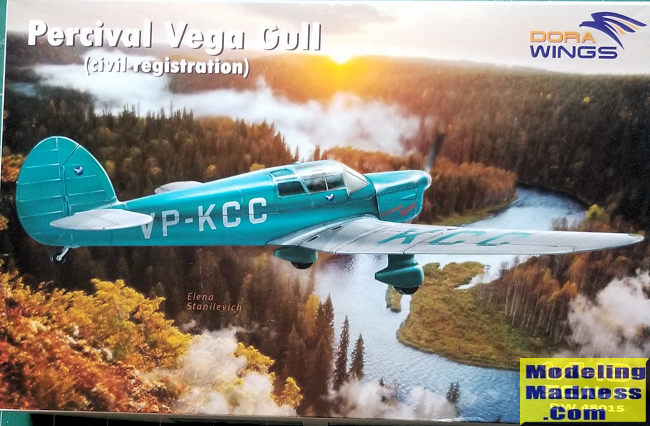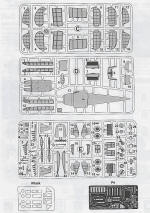
| KIT #: | 48015 |
| PRICE: | $50.00 |
| DECALS: | Four options |
| REVIEWER: | John Summerford |
| NOTES: | There are no color call-outs. Some decals appear off-color and the instrument decal is missing. Scratch building is required for folding the wings. |

| HISTORY |
The Percival Vega Gull was a 1930s British, four-seater touring aircraft built by Percival Aircraft Limited. It was a single-engine, low-wing (Folding), wood-and-fabric monoplane with a fixed tailwheel undercarriage.
Design and development
Built by Percival Aircraft of Gravesend and Luton (after 1936 when Percival Aircraft became a Limited Company), the 'K-Series' Vega Gull was a development of their earlier 'D-Series' Gull. The main changes from the earlier design were the provision of an additional fourth seat, dual controls and flaps. The fuselage was widened and the wingspan increased. Increases in drag were compensated for by reducing parasitic drag from exterior fittings such as hinges and actuation horns. This work was largely attributable to the arrival at Percivals of the talented aircraft designer Arthur Bage. Thus, the Vega Gull was very nearly as fast as the more svelte Gull Six. Payload, range and utility were all much improved. The prototype G-AEAB first flew from Gravesend in November 1935.
The Vega Gull retained the de Havilland Gipsy Six air-cooled inline engine introduced in the D.3 Gull Six of 1934. Most examples were fitted with the optional DH Gipsy Six Series II engine in conjunction with the DH-PD30 VP airscrew. The final Mk II examples were fitted with a curved windscreen (the earlier examples had a multi-faceted windscreen of flat panels) similar in appearance to the early marks of the Proctor.
Operational history
A Vega Gull named "Messenger" was used by Beryl Markham on her transatlantic flight 4–5 September 1936, the first solo east-to-west crossing by a woman.
Two early production Vega Gulls were entered into the Schlesinger Race from England to Johannesburg, South Africa. C.W.A. Scott and Giles Guthrie flying Vega Gull G-AEKE was the only finisher landing at Rand Airport on 1 October 1936. The aircraft had left Portsmouth 52 hours 56 minutes 48 seconds earlier. With the publicity of the win, Percival set up a production line at larger premises at Luton. The new type was an immediate success with production running to 90, the last production aircraft having its maiden flight on 27 July 1939.
The Vega Gull was widely used by British and Commonwealth aviators during the later years of the "Golden Age" of record-setting aviation during the 1930s. Alex Henshaw, Jim Mollison, Amy Johnson, Beryl Markham, C.W.A. Scott and others, won races and broke records to South Africa, South America, Australia and New Zealand, to name but a few.
In addition to civil orders, 15 were ordered by the Air Ministry. Of these, 11 served with 24 Squadron Royal Air Force on communications duties and two were issued to the Fleet Air Arm, which was yet to come under Admiralty control. The remaining two were used by the British air attachés in Buenos Aires and Lisbon. A third aircraft for use by the British air attaché in Berlin was seized by the Germans at the outbreak of the Second World War. It remains unclear whether the Luftwaffe subsequently used this machine.
After the outbreak of war, Vega Gulls were requisitioned for military use. In the UK, 21 were impressed in 1939–40, 14 for the RAF and seven for the FAA. Two aircraft were impressed in each of Australia and India, while one other was "called to the colors" in New Zealand.
By the end of the war, the Vega Gull had been largely supplanted by its younger sibling, the Proctor, of which more than 1,100 were manufactured. Most Proctors, especially the later examples, were slower and more cumbersome than the original Vega. Despite the obvious drawbacks of its wooden airframe in terms of durability, the Vega Gull compares favorably with more modern designs. To save hangar space, the wings could be folded to reduce the space needed for storage.
| THE KIT |
 Upon
opening the box lid, I found five gray plastic sprues, a sprue of clear parts, a
fret of photo-etch, masks for the clear parts, two decal sheets and
instructions, all wedged into a zip-top bag. Molded details are crisp and I’m
delighted with the fabric over rib rendering on the wings and tail. A closer
look reveals that this not a “add glue, shake box” type of build.
Upon
opening the box lid, I found five gray plastic sprues, a sprue of clear parts, a
fret of photo-etch, masks for the clear parts, two decal sheets and
instructions, all wedged into a zip-top bag. Molded details are crisp and I’m
delighted with the fabric over rib rendering on the wings and tail. A closer
look reveals that this not a “add glue, shake box” type of build.
There are 108 injected and
etched parts, not all to be used, plus masks. The breakdown includes a 6-part
wing, 5-part canopy, 4-part landing lights, 3-part fuselage, 3-part spats, a
2-part pitot tube, and two wing blankin g
plates to glue inside the fuselage. (Perhaps you could glue the wings to the
fuselage from inside, then the plates, and then glue the fuselage together.)
There are also three different nose cowls, but no indication as to which one
goes to which aircraft. Only the flat windscreen option is available. Etched
parts include a wiring harness for the engine, but you need to cut the cowl
apart to display the detail. It is possible to pose the cockpit doors open, but
the clear pieces are over thick. Folded wings are not an option. Some mold seams
are very prominent.
g
plates to glue inside the fuselage. (Perhaps you could glue the wings to the
fuselage from inside, then the plates, and then glue the fuselage together.)
There are also three different nose cowls, but no indication as to which one
goes to which aircraft. Only the flat windscreen option is available. Etched
parts include a wiring harness for the engine, but you need to cut the cowl
apart to display the detail. It is possible to pose the cockpit doors open, but
the clear pieces are over thick. Folded wings are not an option. Some mold seams
are very prominent.
Instructions extend over
four pages and comprise 17 steps of conventional sequence. Instruments are to be
represented by a decal, but it is not included. Neither are Color call-outs
included. More internet research revealed period B&W photos of Beryl Markham’s
plane darker inside than outside. One color photo from the early ‘50s of another
airframe shows a nearly black instrument panel with the rest of the interior a
couple shades lighter and the seats still another lighter shade.
Decal options are for four aircraft. All of them have aluminum color wings and tail surfaces. Two feature Wedgewood blue (my sweetheart informs me that’s the color’s name.) fuselages and also the registration letters on the wings. It appears to me that the color of the registration letters is a pale green instead of blue. One option is Beryl Markham’s plane “Messenger” and the other is the Schlesinger race winner. The other two feature a burnt orange fuselage. One option is for a plane based in Cyprus in 1938 and the other sports the markings for the 1952 Kings Cup.
| CONCLUSIONS |
Given how well the parts are detailed, I would be astonished if their fit is sloppy. I’m sure that taking time to clean up the mold seams will take care of any issues and result in a strait forward build. I am concerned about the color of the decals. If you’re tired of painting camouflage schemes, this is a good alternative. My sweetheart likes the notion of seeing Ms. Markham’s blue plane added to the shelf.
John Summerford
May 2019 Copyright ModelingMadness.com If you would like your product reviewed fairly and fairly quickly, please
contact
the editor or see other details in the
Note to
Contributors. Back to the Main Page
Back to the Review
Index Page
Back to the Previews Index Page